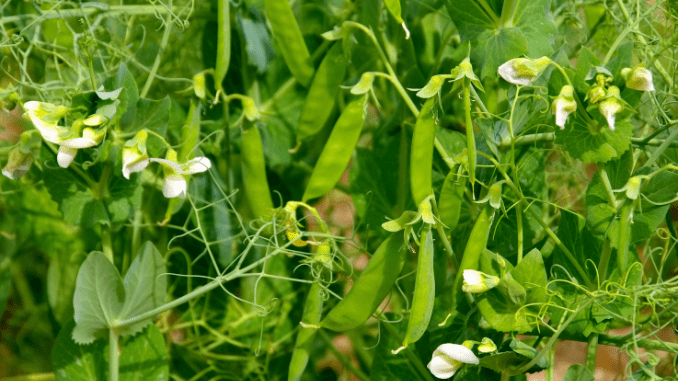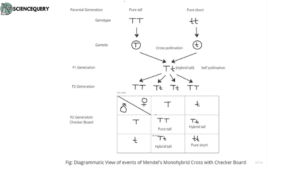
Introduction
Gregor Johann Mendel was a 19th-century Austrian abbot who was also a biologist and mathematician. He started his experiments regarding the pattern of inheritance in 1856. Primarily, he started with mice. However, he later switched to honeybees and garden peas. In the end, garden peas became the primary model for his experiments. Hence, this article is about Gregor Mendel and the pea plant.
He kept on performing the experiments for 10 years. Over 30,000 pea plants were used in this period. His work was completed by 1865. He submitted the results to the local Natural Society. He published his work in 1866, “Experiments in Plant Hybridization”, under the Natural History Society of Brunn.
Reasons for Choosing Pea Plant
- The pea flowers are bisexual (flowers having both male and female reproductive organs).
- The flowers are self-pollinating. So, it allows both self-pollination (pollination occurs by the pollen of the same flower or flowers from the same plant) and cross-pollination (pollination occurs by the pollen of flowers from different plants) to perform.
- The differences in the traits (alternative forms of a single character, like two traits of the character height are tall and short) were easy to recognise.
- Pea is an annual plant. The life cycle is short. Thus, he could monitor the number of generations in a short period (1).
Mendel’s Experimental Design
- Mendel chose garden peas as the primary model for his experiments.
- Pea plants have both male and female flowers, and thus can efficiently perform self-fertilisation. Mendel used this feature for his experiment.
At first, he produced the true-breeding line (where the offspring or child bears identical characteristics as the parents). Then Mendel performed cross-pollination for the next rounds. He crossed one true-breeding plant with another that he had bred earlier. True-breeding plants are parents who have different traits.
The offspring are called the “F1 generation” or the first filial generation. In Latin, the word ‘Filius’ means son. Then, he collected seeds from the plants of the F1 generation. He performed self-fertilization with the plants of F1 generation. The Offspring of this generation is called as F2 generation.
He then continued his experiments for further generations. And counted plants from each generation. He also recorded the number of plants of each different trait.
For his experiments, he chose seven different characters of plants. Each character had two traits, one visible and one non-visible. The visible character is called the dominant trait and the non-visible one is called the recessive trait (2).
| Character | Dominant Trait | Recessive Trait |
| Height of plant | Tall | Short |
| Colour of seed | Yellow | Green |
| Shape of seed | Round | Wrinkled |
| Colour of pod | Green | Yellow |
| Shape of pod | Inflated | Constricted |
| Colour of flower | Purple | White |
| Position of flower | Axial | Terminal |
Experiment and Observation
Mendel wanted to discover how traits were followed in successive generations. For this, he planned the experiments in two different ways. At first, he crossed plants with different character traits considering only one genetic locus (the particular site of a chromosome where the gene is present). This is called a monohybrid cross. When he considered two loci (plural of locus), it is called a dihybrid cross.
The experiment of Monohybrid Cross
In the experiment regarding monohybrid cross, Mendel crossed two true-breeding parents with one having a dominant character and the other having a recessive character. The character he chose was the height of the pea plant. The plants with dominant traits were tall. The recessive ones were short.
T and t are the two alleles (Alleles are two or more alternative forms of genes). For the dominant trait, he used TT (homozygous dominant) and tt (homozygous recessive) for the recessive one. Homozygosity stands for having two identical alleles.
He removed the stamens of parental plants to prevent self-fertilisation (to perform cross-fertilisation). After, getting the F1 generation, he let the plants perform self-fertilisation. He then counted the plants having each kind of trait in the F2 generation. He also determined the genotypic and phenotypic ratio of plants. Genotypes are genetic characters. The visible characters are called phenotypic characters.
Observation

Phenotypic Ratio = Tall : Short = 3 : 1
Genotypic Ratio = TT :Tt : tt = 1 : 2 : 1
The experiment of Dihybrid Cross
In the experiment of the dihybrid cross, two characters were chosen. One is the colour of the seed and another is the shape of the seed. The plant with the dominant character had Yellow-rounded (YYRR) seed. Green-wrinkled (yyrr) stood for seed with a recessive character trait.
The rest of the experiment was done in a similar way to the monohybrid cross. He recorded both genotypic and phenotypic ratios of the F2 offspring.
Observation

Phenotypic ratio = Yellow-round : Yellow-wrinkled : Green-round : Green-wrinkled = 9 : 3 : 3 : 1
Genotypic ratio= YYRR : YYRr : YyRR : YyRr : YYrr : Yyrr : yyRR : yyRr : yyrr = 1 : 2 : 2 : 4 : 1 : 2 : 1 : 2 : 1
Mendel’s law of inheritance
From the result of the above-mentioned experiments, Mendel deduced two laws. These laws explain how the characters are inherited from parents to offspring. These are Mendel’s laws of inheritance.
1. Law of Segregation
This law states that during the formation of gametes, the genes separate from one another and each gamete carries only one allele.
This law was based on the results of the Monohybrid cross. When the F1 generation is produced, the male gamete bears either T or t and the female gamete bears the opposite to that allele of the same (3).
2. Law of Independent Assortment
This law is derived from the results of the Dihybrid cross. According to it, during the inheritance of two different traits, the alleles of each trait are sorted and inherited independently of one another while mixing up in all possible combinations.
The parents in the dihybrid cross are YYRR and yyrr. But when the F1 generation is self-crossed, we find four different kinds of phenotypic characters. The Yellow-round, Green-wrinkled, yellow-wrinkled and green-round. The genotypic variations are even more (3).
Significance and Impact
- Mendel was the first one to give a proper idea about the characters that come in a child from its parents.
- However, he did not have any idea about genes and DNA. He told us that there is a substance in our body, that bears the hereditary factors. He called it ‘element’.
The significance of his study is enormous in terms of genetic study. Thus, he is called “The Father of Genetics”. He discovered how traits move in pairs from parents to offspring. He also stated the dominant and recessive forms of traits (4.).
Rediscovery of Mendel’s work
When Mendel proposed his works in 1866, the science community ignored his works. At that time, other biologists used to think that characters used to pass in blended form. Till his lifetime, he did not get any proper recognition.
In 1900, three scientists, Hugo de Vries, Carl Correns and Erich Von Tschermark found his work individually. Each of them was working on hybrids of different plants. That is when they found out about Mendel’s work. They studied his works before publishing their own (5).
Q&A
1. What is Gregor Mendel’s pea plant experiment?
To discover how the characters flow from parent to child, Gregor Mendel performed experiments using pea plants. He produced hybrids using cross- and self-fertilisations respectively and counted the number of plants of each trait. This is known as Mendel’s pea plant experiment
2. How many pea plants did Mendel study?
Over the decade-long experiments, Mendel studied about 30,000 pea plants.
3. Why did Gregor Mendel use pea plants?
Mendel used pea plants because
- Pea plants are bisexual
- They are self-pollinating. But, cross-pollination can also be performed by removing male reproductive structures.
- The difference in the traits is easy to recognise.
- Peas are annual plants with short life cycles.
Summary
- Gregor Mendel wanted to know how the character flows from parent to child. For that, he performed experiments using pea plants from 1866-1865.
- He chose pae plants as they are bisexual, self-pollinating, and annual with short life cycles. The differences in traits are also easy to recognise.
- He chose seven pairs of character traits for his experiments. One trait of the pair is dominant while the other is recessive.
- For nonhybrid cross, he chose true-breeding tall and short plants and plants with yellow-rounded and seed-wrinkled seeds for dihybrid one.
- Self-pollination was prevented in the parental generation by removing the male reproductive organs. The first generation of offspring is called the F1 generation.
- F1 generation plants are self-fertilised and form F2 generation.
- Based on the results of his experiments, he proposed two laws. These are the law of segregation and the law of independent assortment.
- Till 1900, Mendel did not get his due recognition as the scientist then used to believe the character passes from generation to generation through blended inheritance.
- Hugo de Vries, Carl Correns and Erich Von Tschermark found out about Mendel’s work when each of them was working with hybrids and brought it into the limelight.
